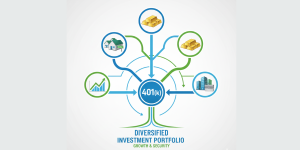As a millennial navigating career growth, student loans, and building your life in Charlotte, retirement planning might seem distant. However, this millennial guide to retirement planning shows that starting in your 20s or 30s gives you a powerful advantage: time. Whether you’re just beginning or already investing, this comprehensive millennial guide to retirement planning will help you build financial security for your future while living your best life today.
Retirement planning doesn’t have to be intimidating. With the help of a fee-only certified financial planner in Charlotte, you can create a personalized strategy that aligns with your goals and lifestyle. Here’s your complete millennial guide to retirement planning.
Millennial’s Guide to Retirement Planning: Essential Questions
What Does Retirement Mean to You?
Every millennial envisions retirement differently. Some dream of traveling the world, taking cruises, or owning a beach house in the Outer Banks. Others see themselves running a passion project, working part-time in a field they love, or starting a business on their own terms without the pressure of a traditional paycheck.
Defining your retirement vision is crucial because it shapes your savings goals and motivates you to start investing early. The clearer your vision, the easier it becomes to create a realistic financial plan. For example, if you want to retire at 55 and travel extensively, you’ll need to save significantly more than someone planning to work part-time until 70. This millennial guide to retirement planning helps you align your daily financial decisions with your long-term retirement dreams.
Consider writing down your retirement vision in detail. What does your ideal day look like? Where do you live? What activities fill your time? How much money do you need monthly to support this lifestyle? These answers will drive your entire retirement strategy and help you stay motivated during the decades of saving ahead.
When Do You Want to Retire?
Traditional retirement at 65 isn’t the only option for millennials. Many aim for early retirement in their 50s through the FIRE (Financial Independence, Retire Early) movement, while others prefer working longer to maximize savings and Social Security benefits. Your target retirement age will determine how aggressively you need to save and invest now.
Consider factors like your career trajectory, health, family plans, and desired lifestyle when setting your retirement timeline. If you’re in your late 20s and want to retire at 55, you have roughly 25-30 years to build your nest egg. Retiring at 55 means your savings need to last potentially 30-40 years, requiring significantly more capital than retiring at 67. According to this millennial guide to retirement planning, starting early and being consistent matters more than the specific age you choose.
Charlotte’s growing economy and relatively low cost of living compared to cities like New York or San Francisco make it an excellent location for millennials focused on retirement planning. The money you save on housing and taxes can be redirected into retirement accounts, accelerating your path to financial independence.
How Will You Fund Your Retirement Years?
Successful millennial retirement planning requires multiple income streams. Beyond traditional savings, consider diversifying with investment properties for passive income, dividend-paying stocks, and maximizing your social security benefits. Following this millennial guide to retirement planning, a comprehensive approach to retirement income will provide greater financial security and flexibility.
Retirement Savings Accounts for Millennials
Understanding your retirement savings accounts is essential for building wealth over time. Here are the key accounts to consider in your millennial retirement planning strategy:
Employer-Sponsored 401(k) Plans
A 401(k) retirement plan is one of the most valuable retirement planning tools available to millennials. Your employer automatically deducts contributions from your paycheck, making saving effortless. Always contribute enough to receive the full employer match—it’s essentially free money toward your retirement.
For 2024, you can contribute up to $23,000 annually to your 401(k), with an additional $7,500 catch-up contribution if you’re 50 or older. If your employer matches 50% of your contributions up to 6% of your salary, and you earn $60,000 annually, that’s an extra $1,800 per year—$54,000 over 30 years before any investment growth. This millennial guide to retirement planning emphasizes that employer matching is the single best investment return you’ll ever find.
Many companies offer automatic annual contribution increases, which is an excellent strategy for gradually building your retirement savings without feeling the impact on your monthly budget. Start with at least enough to get the full match, then increase your contribution by 1-2% each year. By the time you notice, you could be saving 15-20% of your income—the recommended amount for comfortable retirement.
Traditional Individual Retirement Account (IRA)
A Traditional IRA offers tax advantages that can significantly boost your retirement savings. If you’re earning income and under age 70½, you’re eligible to open and contribute to a Traditional IRA. For 2024, the contribution limit is $7,000 annually ($8,000 if you’re 50 or older).
Contributions to Traditional IRAs may be tax-deductible, reducing your current taxable income. However, withdrawals during retirement are taxed as regular income. Early withdrawals before age 59½ typically incur a 10% federal penalty plus regular income tax. Traditional IRAs work best for millennials who expect to be in a lower tax bracket during retirement than they are now.
One advantage of Traditional IRAs is that you control where your money is invested. Unlike 401(k) plans that limit you to specific fund options, IRAs let you invest in individual stocks, bonds, mutual funds, ETFs, and more. This flexibility is particularly valuable as your investment knowledge grows throughout your career.
Roth IRA: The Millennial Advantage
The Roth IRA is particularly attractive for millennials who expect to be in a higher tax bracket during retirement. As emphasized throughout this millennial guide to retirement planning, taking advantage of Roth IRAs while you’re in lower tax brackets is a smart long-term strategy. For 2024, you’re eligible if your modified adjusted gross income is below $146,000 (single filers) or $230,000 (joint filers).
While contributions aren’t tax-deductible, all earnings grow tax-free. Once you reach 59½ and the account has been open for at least five years, withdrawals are completely tax-free—a significant advantage for long-term retirement planning.
Rollover IRA for Job Changers
As a millennial, you’ll likely change jobs multiple times throughout your career. When you leave an employer, rolling your 401(k) into an IRA allows you to maintain tax-deferred growth and avoid early withdrawal penalties. As recommended in this millennial guide to retirement planning, this strategy keeps your retirement planning on track despite career transitions.
Investment Strategies for Millennial Retirement Planning
Smart investing is crucial for millennials who want to maximize their retirement savings. As this millennial guide to retirement planning demonstrates, your 20s and 30s give you a significant advantage: time for compound growth to work its magic.
Consider diversifying your portfolio with stocks, bonds, index funds, and real estate investments. Investment properties can provide passive income both before and during retirement. The key is starting early and staying consistent, allowing your money to work for you while you focus on building your career.
For millennials in their 30s, financial advisors typically recommend an aggressive allocation of 80-90% stocks and 10-20% bonds. This stock-heavy approach maximizes growth potential during your peak earning years. As you approach retirement age, you’ll gradually shift toward more conservative investments to protect your accumulated wealth. A $10,000 investment at age 30 earning an average 8% annual return grows to approximately $147,000 by age 65—demonstrating why this millennial guide to retirement planning emphasizes starting immediately.
Index Funds and ETFs for Millennials
Low-cost index funds and ETFs are ideal for millennials who want market returns without the stress of picking individual stocks. Funds tracking the S&P 500 or total stock market provide instant diversification across hundreds of companies. With expense ratios often below 0.1%, these funds let you keep more of your returns compared to actively managed funds charging 1% or higher.
Target-Date Funds: Set and Forget
Target-date funds automatically adjust your asset allocation as you age, becoming more conservative as your retirement date approaches. If you plan to retire around 2055, you’d choose a 2055 target-date fund. These funds are perfect for millennials who want professional management without constant monitoring. While convenient, check the fees—some target-date funds charge significantly more than buying index funds directly.
Common Retirement Planning Mistakes Millennials Make
Even with the best intentions, millennials often make preventable mistakes that derail their retirement plans. This millennial guide to retirement planning identifies the most common pitfalls and how to avoid them.
Waiting to Start Saving
The biggest mistake millennials make is delaying retirement savings until they feel “financially ready.” Waiting just five years to start investing can cost you hundreds of thousands in lost compound growth. If you start investing $500 monthly at age 25, you’ll have approximately $1.4 million by age 65 (assuming 8% annual returns). Start at age 30, and you’ll only have $950,000—a $450,000 difference from just five years of delay.
Ignoring Employer Match
Approximately 25% of employees don’t contribute enough to receive their full employer 401(k) match. This is literally turning down free money. Before paying extra on student loans, buying a new car, or increasing lifestyle spending, always capture the full employer match. It’s an immediate 50-100% return on investment—something you’ll never find anywhere else in the market.
Cashing Out Retirement Accounts When Changing Jobs
When changing jobs, many millennials cash out their 401(k) instead of rolling it into an IRA or their new employer’s plan. This triggers immediate taxes and a 10% early withdrawal penalty. A $20,000 401(k) withdrawal could cost you $7,000 in taxes and penalties—and you lose decades of potential compound growth. Always roll over retirement accounts to maintain tax-advantaged growth.
Paying Excessive Investment Fees
High investment fees silently erode retirement savings over decades. A 1% annual fee doesn’t sound significant, but on a $500,000 portfolio over 30 years, it can cost you over $150,000 in lost growth compared to a 0.1% fee. Choose low-cost index funds whenever possible and review your 401(k) fund options to ensure you’re not paying unnecessary fees.
Maximizing Retirement Tax Advantages
Tax planning is a critical component of this millennial guide to retirement planning. Understanding how different accounts are taxed can save you tens of thousands over your career.
Tax Diversification Strategy
Don’t put all your retirement eggs in one tax basket. Diversify across Traditional 401(k)/IRA (tax-deferred), Roth IRA (tax-free), and taxable brokerage accounts (taxed annually). This gives you flexibility to optimize tax withdrawal strategies in retirement. You might pull from your Traditional IRA up to the top of a lower tax bracket, then supplement with tax-free Roth withdrawals for the rest of your expenses.
Roth Conversions for Millennials
If you have years with unusually low income—perhaps during graduate school, starting a business, or taking a career break—consider converting Traditional IRA funds to a Roth IRA. You’ll pay taxes on the conversion at your current (low) rate, but all future growth becomes tax-free. This strategy works particularly well for millennials early in their careers before peak earning years.
Take Control of Your Millennial Retirement Future
This millennial guide to retirement planning provides the foundation for building long-term financial security. However, every person’s situation is unique, and working with a certified fee-only financial planner can help you create a customized strategy that accounts for your specific goals, income, and circumstances.
Starting your retirement journey in your 30s gives you an incredible advantage that previous generations didn’t fully leverage. You have access to better technology, lower-cost investment options, and more financial education resources than ever before. The principles outlined in this millennial guide to retirement planning—starting early, maximizing employer matches, choosing the right accounts, diversifying investments, and avoiding common mistakes—will serve you well throughout your career.
Remember that retirement planning isn’t about perfection; it’s about consistency and continuous improvement. Start where you are, use what you have, and increase your contributions as your income grows. Even small steps today compound into significant wealth over decades. The best time to start was yesterday; the second-best time is now.
Calamita Wealth Management specializes in helping individuals and families in Charlotte navigate retirement planning and wealth management. As a Certified Financial Planner® in Charlotte, NC, Todd and his team help you build a comprehensive retirement strategy that grows with you. We understand the unique challenges millennials face—student loan debt, housing costs, career changes—and create plans that address your complete financial picture while keeping retirement goals on track. Contact us today to schedule your consultation and take control of your financial future.







